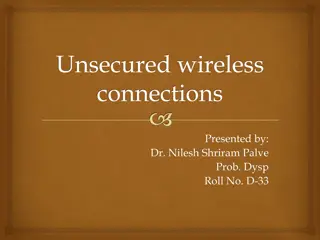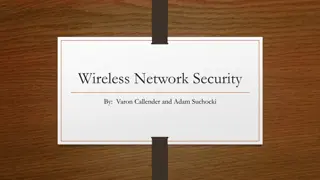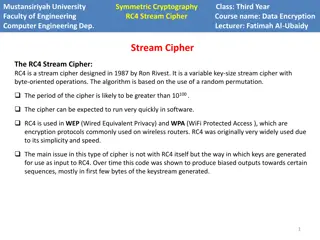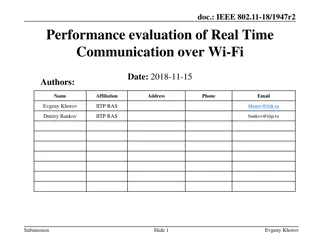
Enhancing Wi-Fi Security Through WPA and WPA2
Discover the evolution of Wi-Fi security protocols from WEP to WPA2, highlighting the flaws of WEP and the improvements brought by WPA and WPA2. Learn how technologies like TKIP and AES have strengthened encryption methods, making networks more secure against potential threats.
Download Presentation

Please find below an Image/Link to download the presentation.
The content on the website is provided AS IS for your information and personal use only. It may not be sold, licensed, or shared on other websites without obtaining consent from the author. If you encounter any issues during the download, it is possible that the publisher has removed the file from their server.
You are allowed to download the files provided on this website for personal or commercial use, subject to the condition that they are used lawfully. All files are the property of their respective owners.
The content on the website is provided AS IS for your information and personal use only. It may not be sold, licensed, or shared on other websites without obtaining consent from the author.
E N D
Presentation Transcript
WPA: A New Hope Wi-Fi Protected Access WEP is terrible, let s find a good alternative Came about in 2003
Haters Gonna Hate WEP s problems: Key Size The key is too small Most of the key is static -> user entered portion Fixed size Not much for generating dynamic keys Reuse of keys Encryption is based on user key We then all use that key
Things to improve Make keys bigger Change keys more often Don t fix the size Don t force it to be hex
TKIP Temporal Key Integrity Protocol Wild idea: change the key used for encryption! TKIP does this per-packet A new 128-bit key is generated for each packet Therefore: not any longer than WEP But it changes Purpose: fix WEP security via a firmware update
Authentication? More complicated process Creates a pairwise master key (PMK) Computed from PSK and SSID Client uses PMK, encrypts exchange of temporary key Called pairwise transient key (PTK) Keys changed every time a client connects Therefore: you and I can t see each other s traffic
Auth/Encryption The final keys are generated from: PMK Client generated random number AP generated random number MAC address of client + AP Pretty good key
Good key? Lots of info go into the key Cracking it is still possible- mostly brute force Still using RC4 Problem with WPA Still ends up with relatively small key (128-bit) TKIP is good, not awesome What s better? WPA2
WPA2 WPA brings in TKIP, pretty good Cracking is (mostly) brute force TKIP s flaws aren t that exploitable -> It s RC4 that is Even better: AES Advanced Encryption Standard Really good encryption! Brutal on crappy CPU s So, the problem with WEP -> WPA transition? The hardware was not ideal
WPA2 -> The better choice! CPU s are much cheaper now WPA2 give us the option: TKIP AES WPA/WPA2 (especially WPA2) Really only brute force methods work
What we need? We need to passively listen Specifically: Clients joiining/leaving the network You can be very stealthy with this As in: impossible to detect WEP -> detectable, sort of What do you need? Airmon & airodump!
Sniffing Fire up airmon airodump-ng --channel --bssid --write mon0
Minimum frames may be needed We don t feel like waiting too long aireplay-ng deauth 10 a BSSID c CLIENT mon0
Cows are cool coWPAtty Fairly fast/efficient WPA cracker One WPA/WPA2 biggie: keys are hashed 4096 times We ll want to use a wordlist cowpatty f <wordlist> -s SSID r captureFile Check /usr/share/wordlists/fasttrack.txt












